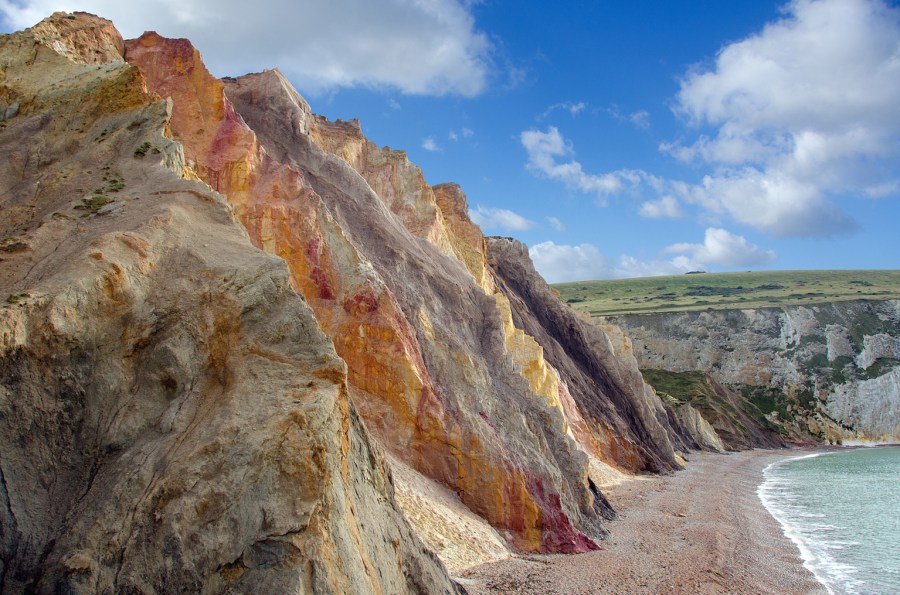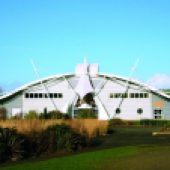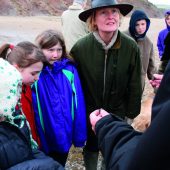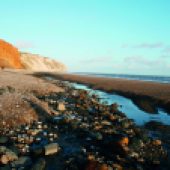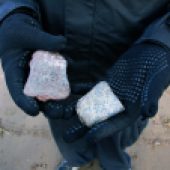Contributor Jo Macaulay headed to the sandy beach of Yaverland near Sandown on the Isle of Wight to go in search of dinosaur fossils
If you’ve ever dreamed of making your own giant reptile discovery, then the Isle of Wight – declared the best location for finding dinosaur fossils in the UK by the Natural History Museum – is where to go. Fossils from the Cretaceous period tumble from the exposed cliffs at Yaverland, or along the west coast of the island, and can even be picked up on the beach.
People have been coming across dinosaur bones for thousands of years, initially thinking they were dragons or giants. Palaeontologist William Buckland first scientifically described the Megalosaurus in 1824 after finding a fossil in Sussex, and in 1829 he visited the Isle of Wight, where he found an Iguanodon toe bone at Yaverland. Fossil hunter Mary Anning, from Lyme Regis in Dorset, made important discoveries from the Jurassic fossil beds there during her lifetime (1799-1847), but it wasn’t until 1842 that the term ‘Dinosauria’ was used by botonist Richard Owen after closely examining an Iguanodon fossil from the Isle of Wight.
Many significant finds have been made on the island since that time. Part of a Neovenator (a large, carnivorous dinosaur) was first spotted by holiday-makers in 1978 and excavated by Steve Hutt, former curator of the island’s dinosaur museum, Dinosaur Isle. In 2009, the fossil of a small Pterosaur was found by islander Daisy Morris when she was just four years old and last year was named Vectidraco daisymorrisae in her honour.
I’ve done some fossil hunting in West Wight in the past, but could do with a bit more guidance, so I head to Yaverland, on the southeastern coast to join a guided walk.
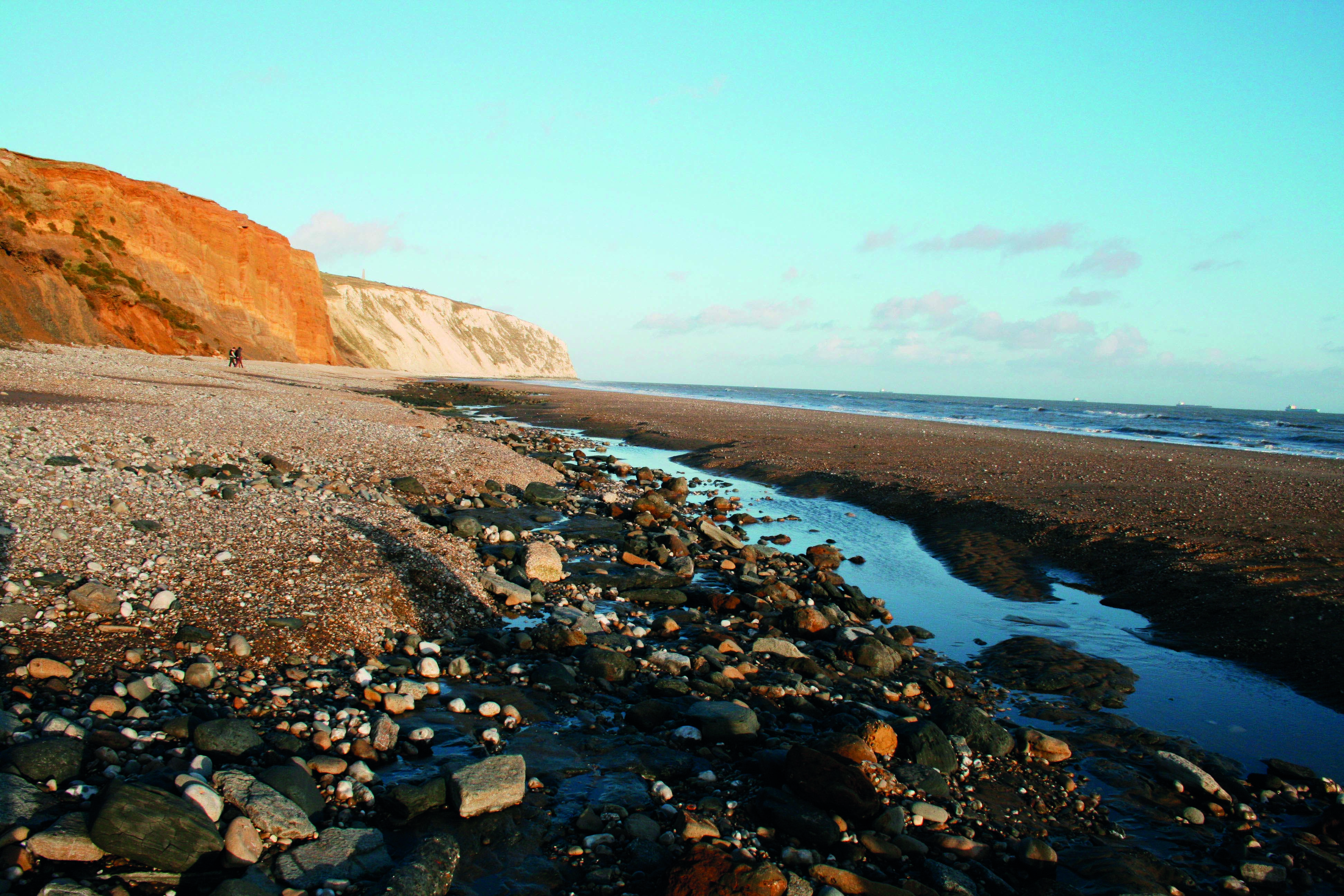
9.30AM OFF WE GO
Dinosaur Isle on the Yaverland seafront was built in 2001 and fittingly resembles a huge Pterosaur. Our 30-strong group of fossil hunters, ranging from five years old to over 60, meets our walk leader Alex Peaker inside the building to have a health and safety talk. He tells us not to get too close to the cliffs and how there can be clay under the sand on the beach that we might step into and sink. Also, we can take our finds from the beach, but anything classed as a boulder (a foot in diameter) has to be left where it is. There’s an air of both anticipation and trepidation as we set off in an easterly direction along the sea wall.
9.45AM PHOTO SHOOT
We arrive at Yaverland Beach, an expanse of golden sand bordered by banded grey and orange cliffs, with the white chalk Culver Cliff in the distance. Some of our party inspect the dinosaur ‘meteorite’ on top of the low cliff. There is an app you can download from the QR code on this ‘rock’ that will conjure up an Iguanodon into the viewfinder of your camera or on to your tablet so you can have your photograph taken with it. There are five more of these rocks, each with a different dinosaur, along the island’s south coast.
10AM LOOKING FOR LAYERS
Next, Alex points out the grey clays and orange sandstones within the cliffs. The layers at this end of the beach made up a flood plain and it is in these deposits of rock that dinosaur remains from the Cretaceous period are found. ‘Further down the beach are the deeper water deposits in which you find marine creatures,’ Alex explains, ‘and the chalk cliffs are made up from the exoskeletons of sea creatures.’ He goes on to tell us that the cliffs at our end of the beach are the Wessex Formation and are 130 million years old, and those where the orange cliffs meet the chalk are 100 million years old. Mind-blowing stuff.
10.15AM BITS OF BONE
Alex shows us a couple of pieces of dinosaur bone that have been found on this beach: one is part of a vertebra and the other from a limb bone. We can make out the trabeculae, the strands that make up the holes in the bone that would have contained bone marrow. ‘When you find bone fossils, these holes are often filled with minerals such as iron pyrites,’ he tells us. This crystal mineral deposit has the colloquial name of ‘fool’s gold’.
10.30AM FOSSIL FINDS
We wander towards the first shingle bed on the beach, because this is one of the best places to find pieces of dinosaur bone washed out of the cliff and rolled in by the sea. Everyone is avidly inspecting stones that might be fossils and taking them to Alex to identify. He explains what he believes each piece to be: some are flints, others sandstones and clays but here and there a fossil is identified. ‘It’s difficult to tell the type of dinosaur, although a lot of Iguanodon remains have been found on this beach,’ he says. By the time we move on, we’ve discovered at least half a dozen pieces of dinosaur bone.
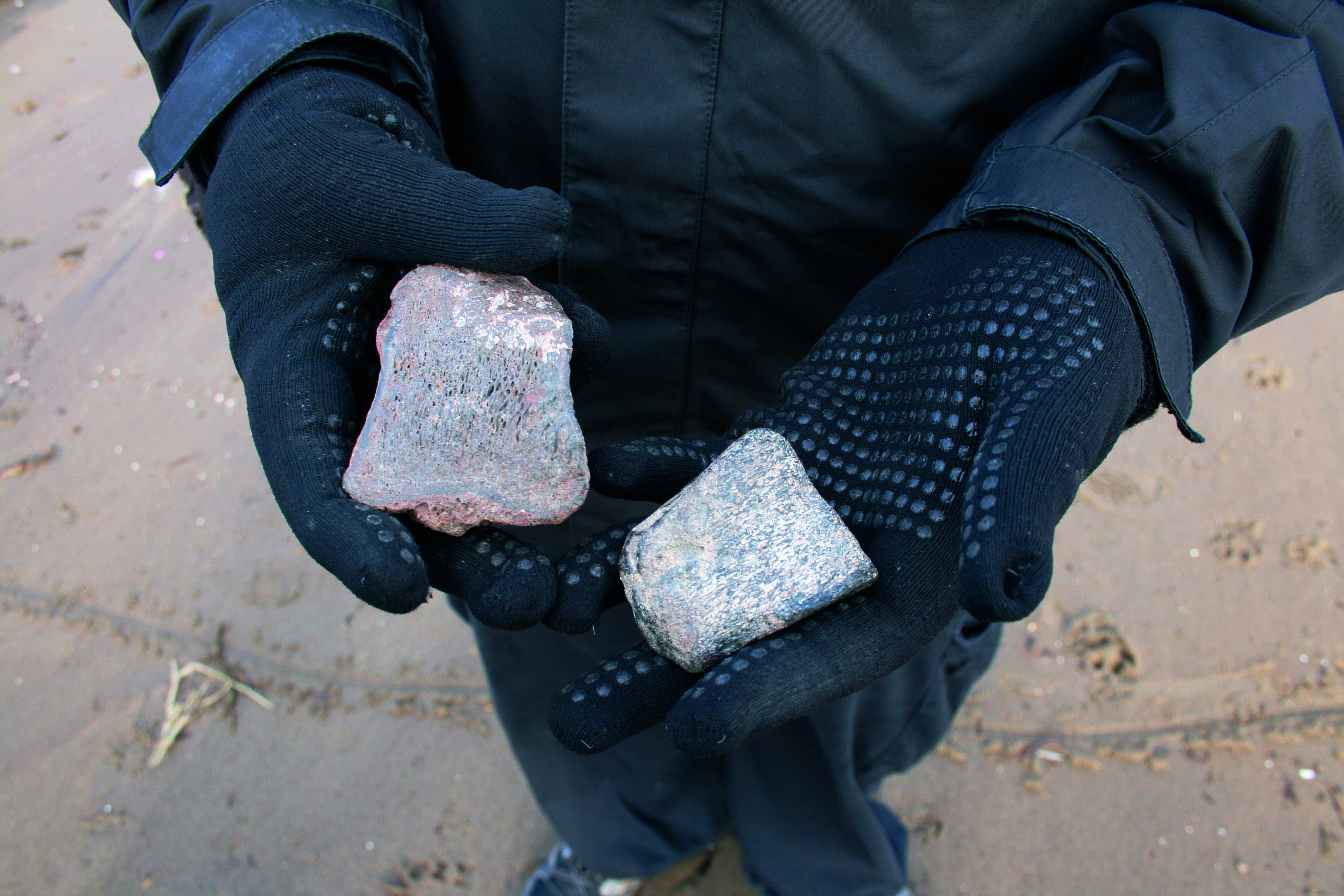
10.45AM PETRIFIED FOREST
As we continue down the beach, Alex points out the black bands in the cliff that are made up of fossilised plant debris, washed down in a flood. The ancient forest is now embedded in the cliff. We then look at the yellow sulphur that is leaching from the shiny fool’s gold in the cracks of the fossilised wood. He finds a piece of flat bone; ‘possibly from a turtle,’ he tells us. While on the beach, we see big chunks of fossilised trees with shiny pyrite deposits in the cracks. I imagine the beach as the marshy estuary it once was, roamed by enormous turtles.
11AM FOOT CASTS
Now he leads us to the dinosaur foot casts that can only be found in one section of the strata. These are imprints of the dinosaur’s footprints that have filled up with sand, which has then hardened over millions of years. None of these are whole but you can see two or three of the huge toes in many of them. Unfortunately, these are often taken from the beach if they are complete.
11.30AM MOLLUSCS
Alex announces that we’re moving from the Wessex Formation to the Vectis Formation, which is about 125 million years old. Here we find mudstone blocks full of clams. ‘Fish scales and shark spines can also be found in these layers,’ says Alex. He shows us a slab that has in it the tooth of a flying dinosaur, a Pterosaur. Then he demonstrates with his hammer how to slice rocks in two to expose the fossils inside.
12PM SUPER SPECIMEN
A little further along, nine-year-old Londoner Samson finds a beautiful fossilised coral. ‘A Holocystis elegans and a fine specimen,’ Alex tells him. This is a great end to the walk as the tide is coming in and we’re in danger of getting wet feet.
12.15PM EXPERT’S EYE
Most people return with pockets or bags of finds. I haven’t actually seen any dinosaur bones but Alex gives me a few pieces he’d picked up. We finish with a tour of Dinosaur Isle, where we make use of the identification window, to have our discoveries examined by the museum’s experts. This walk has been a real eye-opener for me, as I hadn’t realised how plentiful the fossilised remains were at Yaverland. Who knows what I might discover on my next trip. Dinosaur Isle dinosaurisle.com
For more adventure inspiration, click here or pick up a copy of the magazine.
NEED TO KNOW
HOW TO GET STARTED
A guided walk is the best way to begin fossil hunting, but if you want to go yourself, there are a few dos and don’ts to bear in mind. Do take care to leave foot casts for everyone to enjoy. Don’t use tools such as hammers, or hack away at the cliff. Don’t excavate anything. Permission is needed from the landowners for serious investigations. Do report any significant finds to Dinosaur Isle so they can be recorded.
HOW TO GET THERE
Travel to the Isle of Wight by Red Funnel, Hovertravel or Wightlink. The journey takes between 20 minutes and one hour. Then either drive to Yaverland or take the Island Coaster bus from Ryde or Yarmouth ferry terminals.
WHERE TO STAY
The Priory Bay Hotel in St Helen’s. Types of accommodation include en-suite bedrooms, a tithe barn that sleeps four or six, a self-catering Coach House, or a yurt. From £160 for double B&B priorybay.co.uk
WHAT IT COSTS
Guided walks cost from £5 per adult; children (three to 15), £3.70. Families are £16 (2+2) and £18.50 (2+3). Concessions for pensioners and students are £4. As for kit, all you need is a good pair of walking shoes, a hat and sunscreen, and a bag for your finds.

